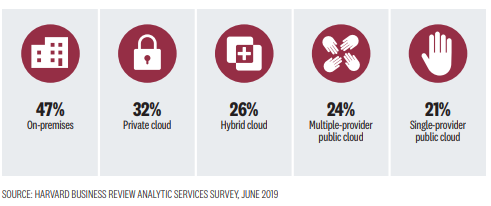

Critical Success Factors: Business Lightning Strikes in the World of Hybrid Clouds
Companies have never had as many opportunities to use the data they have for their own benefit as they do today. But do they take advantage of this opportunity?
Companies have never had as many opportunities to use the data they have for their own benefit as they do today. But do they take advantage of this opportunity? Do they have a developed data strategy? Where are they now and how do they see the future? These are the questions that a management magazine called Harvard Business Review recently asked Cloudera for answers.
The Harvard Business Review Analytic Services survey points to critical points that threaten the company's development and stand in the way of growth and performance. The problem usually stems from the fact that enterprise IT aspects simply do not match business needs, and users consider speed to be more important over security, accuracy and maximum business efficiency.
The survey was conducted at the end of 2019 with the participation of about 185 professionals in senior positions. The diversity of experts is high in several respects. The size of the organizations where the respondents work ranges from less than a hundred employees to corporate giants with ten thousand people, and the companies also cover the tech, banking, consulting and industrial sectors. Completed questionnaires returned to the organizers of the research from four continents of the world.
The results revealed that almost three-quarters (73%) of respondents agree that data sources can play a key role in creating business value, and more than half (51%) plan to do so using multi-cloud.
According to statistics, only 24% of the companies surveyed already use multi-cloud solutions, which is less than half of those who want to use the technology. Of course, the self-managed infrastructure also has a right to exist, since we do not want to release all the data from our hands. In addition, there are various restrictions that directly prohibit certain data from leaving the country. When working with a single cloud provider, vendor lock-in may occur. This means that an organization is so dependent on one cloud provider that it is unable to switch to another provider without significant costs. This, according to research, threatens about 21% of companies.
How respondents' organizations handle data:

In addition to the storage of data, the other important issue was the state of data processing. As it turns out, companies store most of the data that is generated, but mostly they only process it afterwards.
Just over a fifth of companies have stream-processing capabilities and the ability to make real-time decisions based on this incoming data. This gives these companies a business advantage over their competitors, as they have the ability to bid in real time based on user behavior or even perform real-time diagnostics on their devices.
The research also looked at how professionals see the future. The question on the form related to which methods data analytics organizations use now and which ones they plan to use in the next three years.
What data analytics organizations plan to expande/develop over the next three years
(compared to current analytical technologies)

According to the companies surveyed, the role of traditional business intelligence used for reporting and data warehouses is decreasing, and different, truly intelligent processing methods are coming to the fore. Examples include machine learning methods, artificial intelligence developments and intelligent automation solutions. In these areas, an increase of 60% could be achieved in the foreseeable future, according to the respondents of the questionnaire.
Summarizing the experience, more than half of companies want to move to multi-cloud solutions, but only 34% of organizations have a data management strategy to do so, and moving to the cloud entails a number of other challenges.
According to the respondents, it is a significant task that in muli-cloud environments the security and governance rules have to be implemented multiple times with different means, since using the cloud infrastructure we provide an additional attack surface. They also believe that a problem is that the “legacy” applications currently in use are not cloud-compatible, and running a non-cloud-optimized application in the cloud can be significantly more expensive than running on your own infrastructure.
We recommend to your attention the CDP Enterprise Data Management Platform, which greatly facilitates the development of bigdata solutions in hybrid or multi-cloud environments.
















